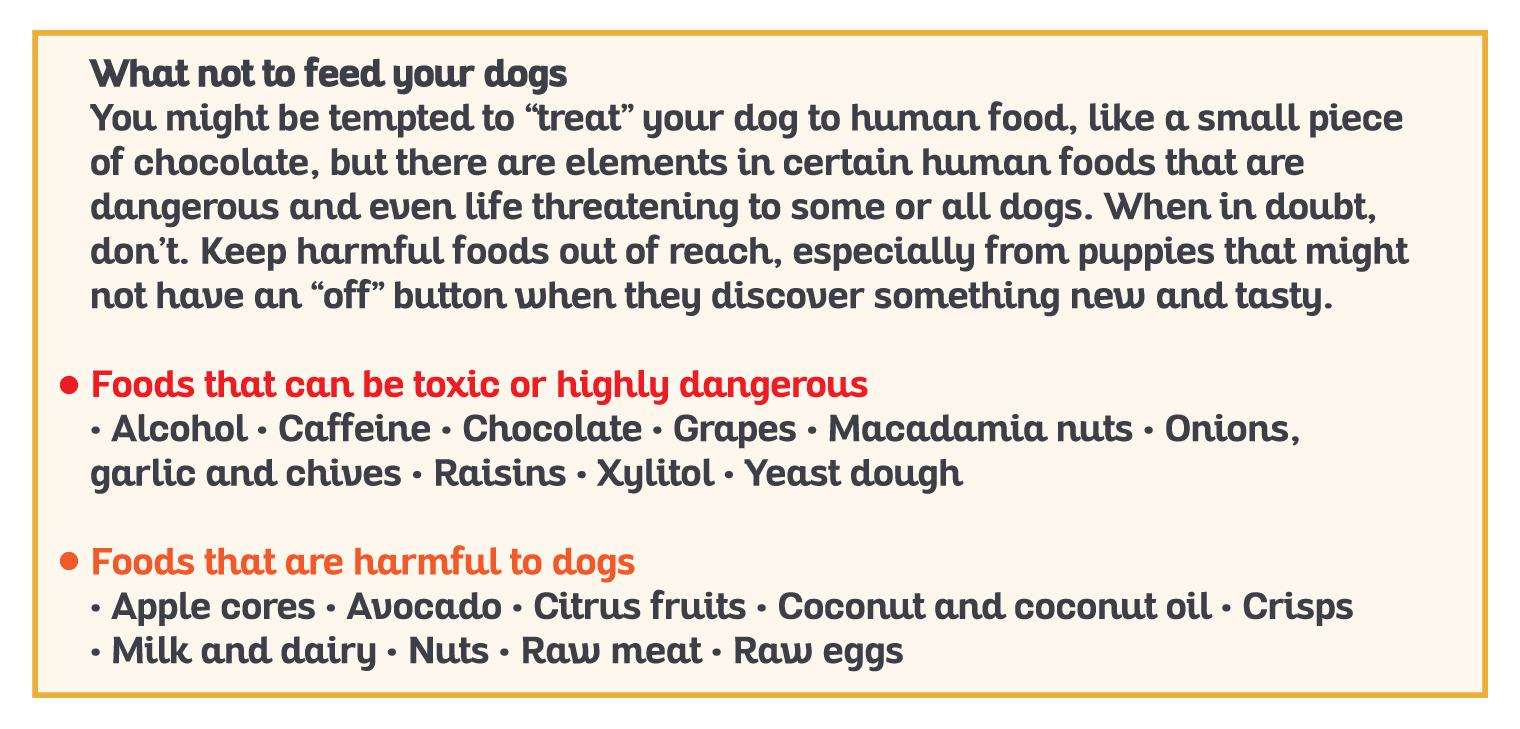Winner, winner, Chicken dinner
Feeding is just one aspect of having dogs as part of your family, but it’s a very important one. What, how, and when you feed your dogs can have considerable impact on their happiness, their health and their quality of life.
These days, there are more dog food brands than we could name, with canned food, raw food, pellets, “homemade” cooked dog food, pouches of wet food and even gravies available. Whatever your budget, there are options that can ensure your dogs get the right nutrition and a really delicious meal (or two) every day.
THE IMPORTANCE OF NUTRIENTS
A dog’s optimum diet should contain six basic nutrients - protein, fats, water, carbohydrates, vitamins, and minerals. The highly essential protein content, along with fats, comes from meat ingredients, while fruits, veggies and grains are vital to provide the other nutrients. Depending on the brands you have access to, it might be worthwhile spending a bit more to ensure healthy concentrations of ingredients and nutrients, and that the food is easily digestible.

WET, DRY OR A COMBINATION?
Wet food is found in cans and pouches, as well as “homemade” meals often found in clear plastic in the frozen foods aisle of the store. Wet food has a more pleasant smell and consistency, most closely resembling meat in its natural state. It may not always have enough of all the nutrients your dog needs, so should be given with a high quality dry food, which is often more nutrient-rich than wet food.
Because dry food has a crunch, it also helps dogs maintain their dental hygiene by reducing plaque and tartar build-up. In general, it is less expensive than wet food, easier to store and has a longer shelf life, so it can be bought in bulk.
A dog’s optimum diet should contain six basic nutrients - protein, fats, water, carbohydrates, vitamins, and minerals.
For these reasons, many people feed a meal of predominantly dry food, with just a bit of wet food and water mixed in, to create a crunchy combination of dry food and soft, meaty flavour. Wet food can go “off” if left open too long, so rather buy small tins or pouches than leave a big can in the fridge for days.
Some lower quality dry dog foods can contain more preservatives and artificial flavours, so always make sure you are choosing a brand with plenty of minerals and vitamins, a high protein content and fewer artificial ingredients.
RAW FOOD
Some people swear by raw food diets, which usually contain a combination of meat, fruit and vegetables and are high in natural nutrients. While this could be a great choice from a nutritional perspective, this option can be expensive, and you may not have a reputable raw food company delivering to your area. Another downside is that generally, we are advised not to mix dry pellets with raw food, so the dogs are not receiving the benefit of the crunch that helps with oral hygiene.
HOMEMADE FOOD
There is also the option to make your own wet food or buy cooked wet food that is “homemade”, in other words, has not been processed and has no artificial ingredients. These foods usually contain rice and other grains, cooked meat and vegetables. The nutritional value and freshness of the food will heavily depend on who’s making it, so be sure you know exactly where it comes from.

Proper homemade dog food is not inexpensive, so if you have the time, you could make your own. All you would needs is a big pot, some chicken livers and/or meat offcuts (no bones), plenty of chopped up veggies (nothing from the onion family), and rice. Once cooked and cooled completely, scoop into plastic containers and freeze.
SHOULD YOU GIVE BONES?
When we think of giving a dog a “treat”, most often the first thing that comes to mind is a bone, but not all of them are good for your dogs. Unless your dog has digestive issues or pancreatitis, big, raw beef bones are a good option as they’re fresh and flavoursome, have no artificial flavours or preservatives, and are unlikely to splinter. Freeze them on the day you buy them to keep them fresher and reduce the risk of contamination and bacterial infections.

Avoid giving your dogs cooked bones, as they can splinter and cause cuts in the mouth or digestive tract. This applies to any meat – pork, chicken, beef or lamb. Rather give bones when you can keep an eye on your dog/s, just in case something happens. Once the bone starts to get smaller, take it away before it becomes a choking or bacterial hazard.

FEEDING TIMES
Wherever possible, stick to a strict feeding routine. Dogs are creatures of habit and anticipate their mealtimes, so it’s good for their “inner peace”, and better for their metabolism and gut health. Another benefit is that if you feed your dogs at the same time every day, it will also be easier to notice if they suddenly have a lack of appetite – often the first sign that your pet is sick.

HOW OFTEN SHOULD A DOG EAT?
Most dogs need to be fed once or twice a day, although very small dogs would be happy to have three smaller meals, and young puppies might be fed up to five times a day. As a general rule, the smaller the dog, the smaller and more frequent its meals should be. This is because they have fast metabolisms, and burn energy more quickly, which makes them more sensitive to low blood sugar levels. Interestingly, the same applies to giant dog breeds. They often have digestive issues and could also benefit from three smaller meals a day.
Whatever you choose to feed, always speak to your vet first to find out what’s best for your dog’s size, breed, sensitivities and lifestyle.



